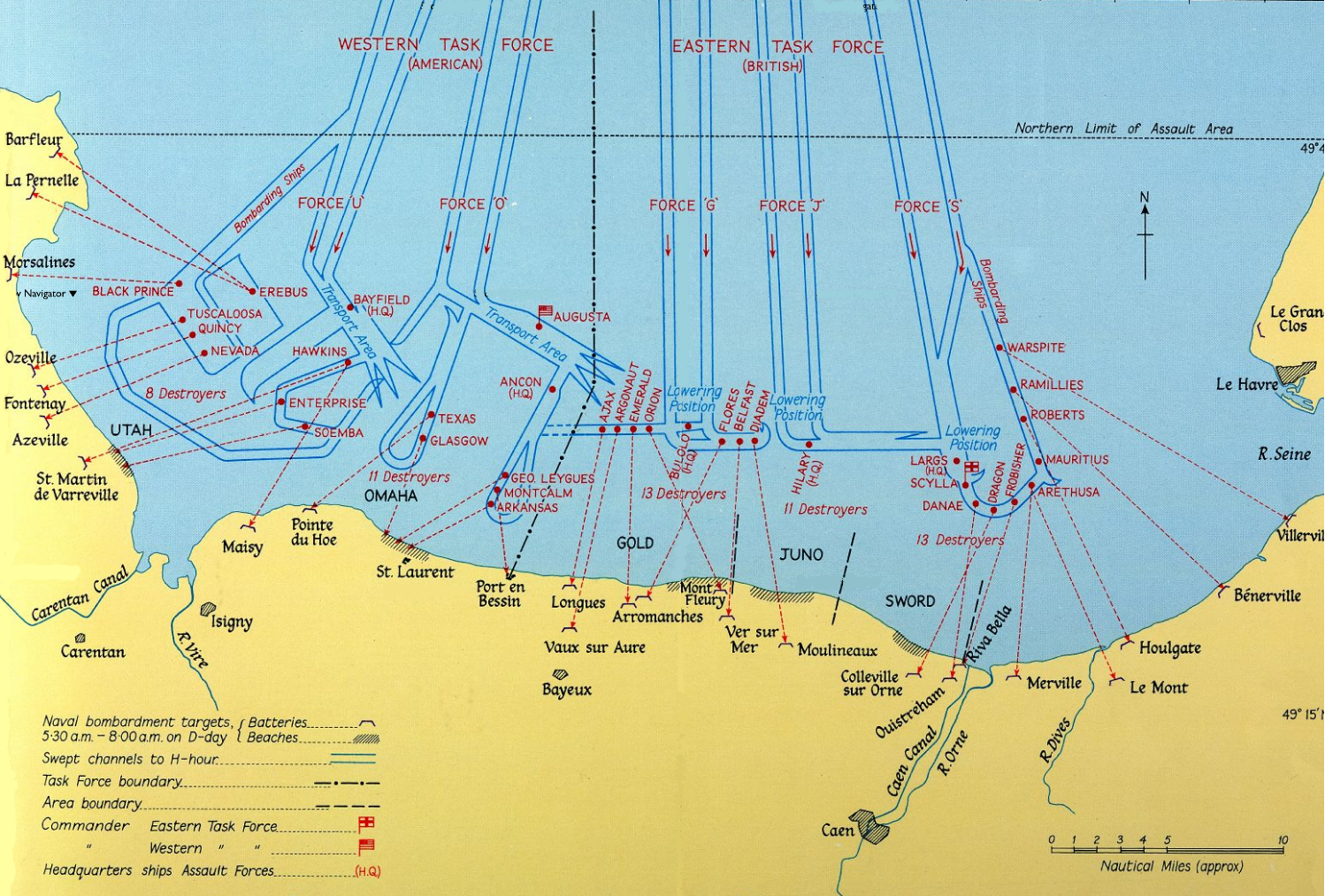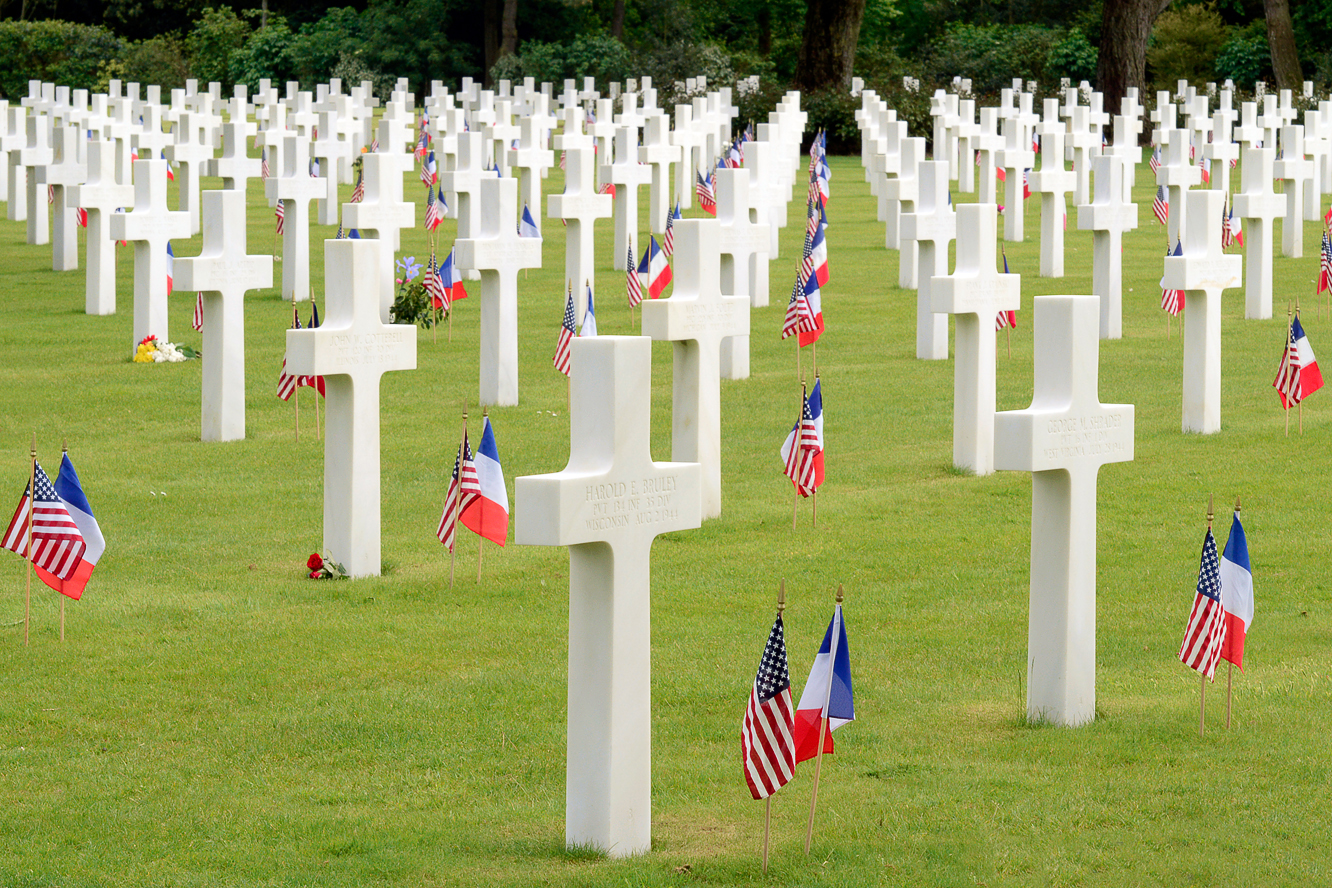|
Les Gateys National Cemetery
Les Gateys National Cemetery (also called Les Gateys National Necropolis (french: Nécropole Nationale des Gateys)) is a Second World War French military war grave cemetery, located close to the village of Saint-Nicolas-des-Bois and north-west of Alençon in the Orne, Normandy, France. It contains the graves of 19 French soldiers from the 2nd Armoured Division that died during the Battle of Alençon in August 1944. History The soldiers interred in this small cemetery were part of General Philippe Leclerc de Hauteclocque's French 2nd Armoured Division. The division had landed on 1 August 1944 at Saint-Martin-de-Varreville, close to Utah Beach. The division was involved in the encirclement of German forces in what became known as the Falaise Pocket. The soldiers here were killed during the Battle of Alençon in August 1944. The division later played a major part in the liberation of Paris. Formation The site, located in the forest of Écouves, was originally a battlefield ce ... [...More Info...] [...Related Items...] OR: [Wikipedia] [Google] [Baidu] |
Alençon
Alençon (, , ; nrf, Alençoun) is a commune in Normandy, France, capital of the Orne department. It is situated west of Paris. Alençon belongs to the intercommunality of Alençon (with 52,000 people). History The name of Alençon is first recorded in a document dated in the seventh century. During the tenth century, Alençon was a buffer state between Normandy and the Maine regions. In 1049–1051, William Duke of Normandy, later known as William the Conqueror and king of England, laid siege to the town, which had risen in support of the Count of Anjou along with two other towns of the Bellême estates, Domfront (then in Maine) and Bellême (held directly from King Henry I of France). According to Duke William's chaplain and panegyrist, William of Poitiers, the defenders of the fortress refused to surrender and mockingly waved animal hides from the castle walls, referencing William's lineage as the grandson of a tanner. In response to this, William had 32 prisoners of the ... [...More Info...] [...Related Items...] OR: [Wikipedia] [Google] [Baidu] |
Utah Beach
Utah, commonly known as Utah Beach, was the code name for one of the five sectors of the Allied invasion of German-occupied France in the Normandy landings on June 6, 1944 (D-Day), during World War II. The westernmost of the five code-named landing beaches in Normandy, Utah is on the Cotentin Peninsula, west of the mouths of the Douve and Vire rivers. Amphibious landings at Utah were undertaken by United States Army troops, with sea transport, mine sweeping, and a naval bombardment force provided by the United States Navy and Coast Guard as well as elements from the British, Dutch and other Allied navies. The objective at Utah was to secure a beachhead on the Cotentin Peninsula, the location of important port facilities at Cherbourg. The amphibious assault, primarily by the US 4th Infantry Division and 70th Tank Battalion, was supported by airborne landings of the 82nd and 101st Airborne Division. The intention was to rapidly seal off the Cotentin Peninsula, prevent the G ... [...More Info...] [...Related Items...] OR: [Wikipedia] [Google] [Baidu] |
World War II Cemeteries In France
In its most general sense, the term "world" refers to the totality of entities, to the whole of reality or to everything that is. The nature of the world has been conceptualized differently in different fields. Some conceptions see the world as unique while others talk of a "plurality of worlds". Some treat the world as one simple object while others analyze the world as a complex made up of many parts. In ''scientific cosmology'' the world or universe is commonly defined as " e totality of all space and time; all that is, has been, and will be". '' Theories of modality'', on the other hand, talk of possible worlds as complete and consistent ways how things could have been. ''Phenomenology'', starting from the horizon of co-given objects present in the periphery of every experience, defines the world as the biggest horizon or the "horizon of all horizons". In ''philosophy of mind'', the world is commonly contrasted with the mind as that which is represented by the mind. ''Th ... [...More Info...] [...Related Items...] OR: [Wikipedia] [Google] [Baidu] |
World War II Memorials In France
In its most general sense, the term "world" refers to the totality of entities, to the whole of reality or to everything that is. The nature of the world has been conceptualized differently in different fields. Some conceptions see the world as unique while others talk of a "plurality of worlds". Some treat the world as one simple object while others analyze the world as a complex made up of many parts. In ''scientific cosmology'' the world or universe is commonly defined as " e totality of all space and time; all that is, has been, and will be". '' Theories of modality'', on the other hand, talk of possible worlds as complete and consistent ways how things could have been. ''Phenomenology'', starting from the horizon of co-given objects present in the periphery of every experience, defines the world as the biggest horizon or the "horizon of all horizons". In ''philosophy of mind'', the world is commonly contrasted with the mind as that which is represented by the mind. ''Th ... [...More Info...] [...Related Items...] OR: [Wikipedia] [Google] [Baidu] |
List Of Military Cemeteries In Normandy
The following military cemeteries were established in the French region of Normandy in memory for casualties of the World War II battles there: American * The Normandy American Cemetery and Memorial, located near the battle site at Omaha Beach. * The Brittany American Cemetery and Memorial, located near Saint-James. Despite the name of the cemetery, it is located in Normandy, on the border with Brittany. British * Banneville-la-Campagne War Cemetery contains 2,175 Commonwealth burials of the Second World War with a high number of casualties from Operation Goodwood interred in the cemetery. * Bayeux War Cemetery contains 4,144 Commonwealth burials of the Second World War, 338 of them unidentified. There are also over 500 war graves of other nationalities, the majority German. * Brouay War Cemetery contains 375 British and 2 Canadian graves with a high number of casualties from the 53rd (Welsh) Division. * Cambes-en-Plaine War Cemetery contains 223 graves of those that fe ... [...More Info...] [...Related Items...] OR: [Wikipedia] [Google] [Baidu] |
Jacques Massu
Jacques Émile Massu (; 5 May 1908 – 26 October 2002) was a French general who fought in World War II, the First Indochina War, the Algerian War and the Suez crisis. He led French troops in the Battle of Algiers, first supporting and later denouncing their use of torture. Early life Jacques Massu was born in Châlons-sur-Marne to a family of military officers; his father was an artillery officer. He studied successively at Saint-Louis de Gonzague in Paris, the Free College of Gien (1919–1925) and Prytanée National Militaire (1926–1928). He then entered Saint-Cyr and graduated in 1930 as a second lieutenant in the promotion class "Marshal Foch" and chose the Colonial Infantry. Between October, 1930 and August, 1931, he served in the 16th Senegalese Tirailleur Regiment (16th RTS) in Cahors. He was sent to Morocco with the 5th RTS and took part in the fighting around Tafilalt where he earned his first citation. He was promoted to lieutenant in October 1932 and took part ... [...More Info...] [...Related Items...] OR: [Wikipedia] [Google] [Baidu] |
Forêt D'Écouves
The Forêt d'Écouves (; eng. Écouves Forest) is a large area of woodland in the Normandy region of northern France. Location and topography The forest is located in the Orne département of France, north of Alençon, between the communes of Carrouges in the west and Sées in the east. It covers an area of approximately , being east to west and between wide. It is generally between above sea level, although at one point the elevation rises to above sea level, which is the highest point in all of Normandy. The forest comprises part of the Normandie-Maine Regional Natural Park, founded in 1975, along with the Andaines and Perseigne forests. Flora and fauna Approximately hectares of the land covered by the forest is varied planting of broad-leaved (mainly sessile oak and beech) and pine (mainly Scots pine) trees. It is well known for its varied wildlife, particularly deer and birds. Wolves were historically a common feature of the forest, the last recorded capture being i ... [...More Info...] [...Related Items...] OR: [Wikipedia] [Google] [Baidu] |
Saint-Martin-de-Varreville
Saint-Martin-de-Varreville () is a commune in the Manche department in Normandy in north-western France. See also *Communes of the Manche department The following is a list of the 446 communes of the Manche department of France. The communes cooperate in the following intercommunalities (as of 2020):Saintmartindevarreville Populated coastal places in France {{Manche-geo-stub ... [...More Info...] [...Related Items...] OR: [Wikipedia] [Google] [Baidu] |
Normandy
Normandy (; french: link=no, Normandie ; nrf, Normaundie, Nouormandie ; from Old French , plural of ''Normant'', originally from the word for "northman" in several Scandinavian languages) is a geographical and cultural region in Northwestern Europe, roughly coextensive with the historical Duchy of Normandy. Normandy comprises mainland Normandy (a part of France) and the Channel Islands (mostly the British Crown Dependencies). It covers . Its population is 3,499,280. The inhabitants of Normandy are known as Normans, and the region is the historic homeland of the Norman language. Large settlements include Rouen, Caen, Le Havre and Cherbourg. The cultural region of Normandy is roughly similar to the historical Duchy of Normandy, which includes small areas now part of the departments of Mayenne and Sarthe. The Channel Islands (French: ''Îles Anglo-Normandes'') are also historically part of Normandy; they cover and comprise two bailiwicks: Guernsey and Jersey, which are B ... [...More Info...] [...Related Items...] OR: [Wikipedia] [Google] [Baidu] |
Philippe Leclerc De Hauteclocque
Philippe François Marie Leclerc de Hauteclocque (22 November 1902 – 28 November 1947) was a Free-French general during the Second World War. He became Marshal of France posthumously in 1952, and is known in France simply as le maréchal Leclerc or just Leclerc. The son of an aristocratic family, Hauteclocque graduated from the ''École spéciale militaire de Saint-Cyr'', the French military academy, in 1924. After service with the French Occupation of the Ruhr and in Morocco, he returned to Saint-Cyr as an instructor. He was awarded the '' croix de guerre des théâtres d'opérations extérieures'' for leading ''goumiers'' in an attack on caves and ravines on Bou Amdoun on 11 August 1933. During the Second World War he fought in the Battle of France. He was one of the first who defied his government's Armistice to make his way to Britain to fight with the Free French under General Charles de Gaulle, adopting the '' nom de guerre'' of Leclerc so that his wife and childre ... [...More Info...] [...Related Items...] OR: [Wikipedia] [Google] [Baidu] |





